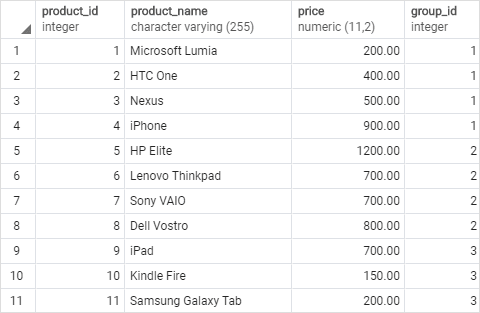PostgreSQL FIRST_VALUE Function
Summary: in this tutorial, you will learn how to use the PostgreSQL FIRST_VALUE() function to return the first value in a sorted partition of a result set.
Introduction to PostgreSQL FIRST_VALUE() function
The FIRST_VALUE() function returns a value evaluated against the first row in a sorted partition of a result set.
The following is the syntax of the FIRST_VALUE() function:
FIRST_VALUE ( expression )
OVER (
[PARTITION BY partition_expression, ... ]
ORDER BY sort_expression [ASC | DESC], ...FIRST_VALUE ( expression )
OVER (
[PARTITION BY partition_expression, ... ]
ORDER BY sort_expression [ASC | DESC], ...
)In this syntax:
expression
The expression can be an expression, column, or subquery evaluated against the value of the first row of a sorted partition of a result set. The expression must return a single value. And it cannot be a window function.
PARTITION BY clause
The PARTITION BY clause divides rows in a result set into partitions to which the FIRST_VALUE() function is applied.
When you the PARTITION BY clause, the FIRST_VALUE() function treats the whole result set as a single partition.
ORDER BY clause
The ORDER BY clause specifies the sort order of rows in each partition to which the FIRST_VALUE()function is applied.
rows_range_clause
The rows_range_clause further limits the rows within the partition by defining the start and end in the partition
PostgreSQL FIRST_VALUE() function examples
We will use the products table created in the window function tutorial for the demonstration:
 The data of the
The data of the products table is as follows:

1) Using PostgreSQL FIRST_VALUE() function over a result set example
The following statement uses the FIRST_VALUE() function to return all products and also the product which has the lowest price:
SELECT
product_id,
product_name,
group_id,
price,
FIRST_VALUE(product_name)
OVER(
ORDER BY price
) lowest_price
FROM
products;Here is the result set:
 In this example:
In this example:
- Since we skipped the
PARTITION BYclause in theFIRST_VALUE()function, the function treated the whole result set as a single partition. - The
ORDER BYclause sorted products by prices from low to high. - The
FIRST_VALUE()function is applied to the whole result set and picked the value in theproduct_namecolumn of the first row.
2) Using FIRST_VALUE() function over a partition example
This statement uses the FIRST_VALUE() function to return all products grouped by the product group. And for each product group, it returns the product with the lowest price:
SELECT
product_id,
product_name,
group_id,
price,
FIRST_VALUE(product_name)
OVER(
PARTITION BY group_id
ORDER BY price
RANGE BETWEEN
UNBOUNDED PRECEDING AND
UNBOUNDED FOLLOWING
) lowest_price
FROM
products; In this example:
In this example:
- The
PARTITION BYclause distributed products by product group. - The
ORDER BYclause sorted products in each product group (partition) by prices from low to high. - The
RANGE BETWEEN UNBOUNDED PRECEDING AND UNBOUNDED FOLLOWINGclause defined the frame in each partition, starting from the first row and ending at the last row. - The
FIRST_VALUE()function is applied to each partition separately.
In this tutorial, you have learned how to use the PostgreSQL FIRST_VALUE() function to return the first value in a sorted partition of a result set.